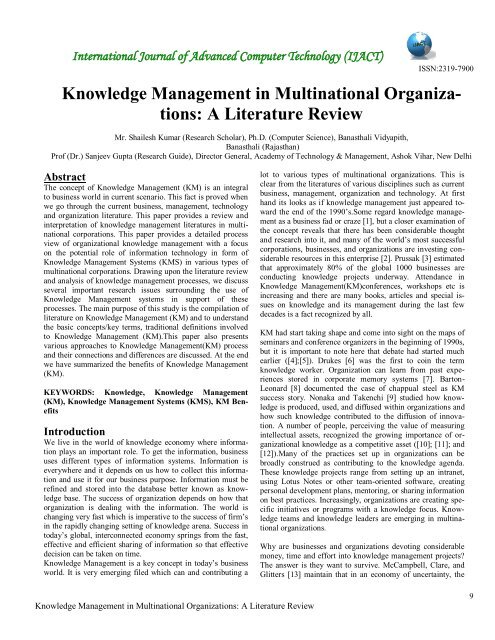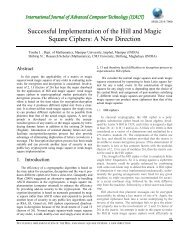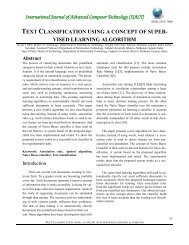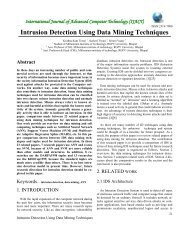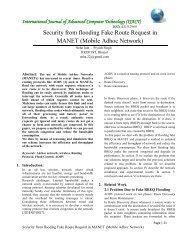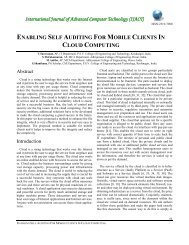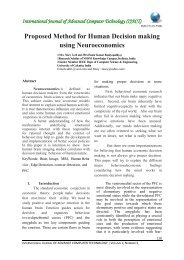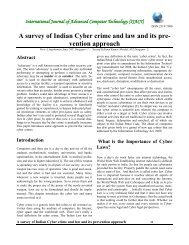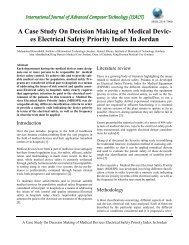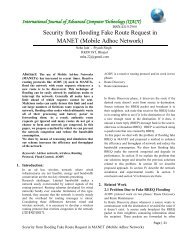A Literature Review - International Journal of Advanced Computer ...
A Literature Review - International Journal of Advanced Computer ...
A Literature Review - International Journal of Advanced Computer ...
Create successful ePaper yourself
Turn your PDF publications into a flip-book with our unique Google optimized e-Paper software.
<strong>International</strong> <strong>Journal</strong> <strong>of</strong> <strong>Advanced</strong> <strong>Computer</strong> Technology (IJACT)ISSN:2319-7900Knowledge Management in Multinational Organizations:A <strong>Literature</strong> <strong>Review</strong>Mr. Shailesh Kumar (Research Scholar), Ph.D. (<strong>Computer</strong> Science), Banasthali Vidyapith,Banasthali (Rajasthan)Pr<strong>of</strong> (Dr.) Sanjeev Gupta (Research Guide), Director General, Academy <strong>of</strong> Technology & Management, Ashok Vihar, New DelhiAbstractThe concept <strong>of</strong> Knowledge Management (KM) is an integralto business world in current scenario. This fact is proved whenwe go through the current business, management, technologyand organization literature. This paper provides a review andinterpretation <strong>of</strong> knowledge management literatures in multinationalcorporations. This paper provides a detailed processview <strong>of</strong> organizational knowledge management with a focuson the potential role <strong>of</strong> information technology in form <strong>of</strong>Knowledge Management Systems (KMS) in various types <strong>of</strong>multinational corporations. Drawing upon the literature reviewand analysis <strong>of</strong> knowledge management processes, we discussseveral important research issues surrounding the use <strong>of</strong>Knowledge Management systems in support <strong>of</strong> theseprocesses. The main purpose <strong>of</strong> this study is the compilation <strong>of</strong>literature on Knowledge Management (KM) and to understandthe basic concepts/key terms, traditional definitions involvedto Knowledge Management (KM).This paper also presentsvarious approaches to Knowledge Management(KM) processand their connections and differences are discussed. At the endwe have summarized the benefits <strong>of</strong> Knowledge Management(KM).KEYWORDS: Knowledge, Knowledge Management(KM), Knowledge Management Systems (KMS), KM BenefitsIntroductionWe live in the world <strong>of</strong> knowledge economy where informationplays an important role. To get the information, businessuses different types <strong>of</strong> information systems. Information iseverywhere and it depends on us how to collect this informationand use it for our business purpose. Information must berefined and stored into the database better known as knowledgebase. The success <strong>of</strong> organization depends on how thatorganization is dealing with the information. The world ischanging very fast which is imperative to the success <strong>of</strong> firm‟sin the rapidly changing setting <strong>of</strong> knowledge arena. Success intoday‟s global, interconnected economy springs from the fast,effective and efficient sharing <strong>of</strong> information so that effectivedecision can be taken on time.Knowledge Management is a key concept in today‟s businessworld. It is very emerging filed which can and contributing alot to various types <strong>of</strong> multinational organizations. This isclear from the literatures <strong>of</strong> various disciplines such as currentbusiness, management, organization and technology. At firsthand its looks as if knowledge management just appeared towardthe end <strong>of</strong> the 1990‟s.Some regard knowledge managementas a business fad or craze [1], but a closer examination <strong>of</strong>the concept reveals that there has been considerable thoughtand research into it, and many <strong>of</strong> the world‟s most successfulcorporations, businesses, and organizations are investing considerableresources in this enterprise [2]. Prussak [3] estimatedthat approximately 80% <strong>of</strong> the global 1000 businesses areconducting knowledge projects underway. Attendance inKnowledge Management(KM)conferences, workshops etc isincreasing and there are many books, articles and special issueson knowledge and its management during the last fewdecades is a fact recognized by all.KM had start taking shape and come into sight on the maps <strong>of</strong>seminars and conference organizers in the beginning <strong>of</strong> 1990s,but it is important to note here that debate had started muchearlier ([4];[5]). Drukes [6] was the first to coin the termknowledge worker. Organization can learn from past experiencesstored in corporate memory systems [7]. Barton-Leonard [8] documented the case <strong>of</strong> chappual steel as KMsuccess story. Nonaka and Takenchi [9] studied how knowledgeis produced, used, and diffused within organizations andhow such knowledge contributed to the diffusion <strong>of</strong> innovation.A number <strong>of</strong> people, perceiving the value <strong>of</strong> measuringintellectual assets, recognized the growing importance <strong>of</strong> organizationalknowledge as a competitive asset ([10]; [11]; and[12]).Many <strong>of</strong> the practices set up in organizations can bebroadly construed as contributing to the knowledge agenda.These knowledge projects range from setting up an intranet,using Lotus Notes or other team-oriented s<strong>of</strong>tware, creatingpersonal development plans, mentoring, or sharing informationon best practices. Increasingly, organizations are creating specificinitiatives or programs with a knowledge focus. Knowledgeteams and knowledge leaders are emerging in multinationalorganizations.Why are businesses and organizations devoting considerablemoney, time and effort into knowledge management projects?The answer is they want to survive. McCampbell, Clare, andGlitters [13] maintain that in an economy <strong>of</strong> uncertainty, theKnowledge Management in Multinational Organizations: A <strong>Literature</strong> <strong>Review</strong>9
<strong>International</strong> <strong>Journal</strong> <strong>of</strong> <strong>Advanced</strong> <strong>Computer</strong> Technology (IJACT)6 Knowledge is reasoning about informationto actively guide task execution, problemsolvingand decision-making in order toperform, learn and teach7 Knowledge is defined as understanding theeffects <strong>of</strong> input variables on the output.8 Knowledge as new or modified insight orpredictive understanding.9 Knowledge is the whole set <strong>of</strong> insights, experiences,and procedures which are consideredcorrect and true, and which thereforeguide the thoughts, behaviors, andcommunication <strong>of</strong> people.10 Knowledge is justified personal belief thatincreases an individual‟s capacity to take effectiveaction.11 Knowledge refers to an individual's stock <strong>of</strong>information, skills, experience, beliefs andmemories.12 Knowledge originates in the head <strong>of</strong> an individual(the mental state <strong>of</strong> having ideas,facts, concepts, data and techniques, as recordedin an individual‟s memory) andbuilds on information that is transformedand enriched by personal experience, beliefsand values with decision and action-relevantmeaning. Knowledge formed by an individualcould differ from knowledge possessedby another person receiving the same informationBeckman[96]Bohn[97]Kock &Queen[98]Van derSpek &Spijkervet[99]Alavi &Leidner[100]Alexander&Schallert[101]Bender &Fish[102]Knowledge ManagementKnowledge management (KM) is very important for organizationbecause it will help organization to have competitive advantageand effective work through sharing and re-use <strong>of</strong>knowledge in an organization. In the market place <strong>of</strong> e-business, KM initiatives are used to systematically leverage informationand expertise to improve organizational responsiveness,innovation, competency and efficiency. There are manyreasons why knowledge should be managed properly in an organization.Among the reasons are as follows: informationoverloads, technology advancement, increased pr<strong>of</strong>essionalspecialization, competition, workforce mobility and turnover,and capitalizes on organizational knowledge.Knowledge Management is about building organizational intelligenceby enabling people to improve the way they work incapturing, sharing and using knowledge. It involves using theideas and experience <strong>of</strong> employees, customers and suppliers toimprove the organizations‟ performance. Building on whatworks well leads to better practice, strategy and policy [103].Variety <strong>of</strong> disciplines have influenced and informed the field<strong>of</strong> KM thinking and practice - prominent being philosophy, indefining knowledge; cognitive science (in understandingKnowledge Management in Multinational Organizations: A <strong>Literature</strong> <strong>Review</strong>ISSN:2319-7900knowledge workers); social science (understanding motivation,people, interactions, culture, environment); managementscience (optimizing operations and integrating them within theenterprise); information science (building knowledge-relatedcapabilities); knowledge engineering (eliciting and codifyingknowledge); artificial intelligence (automating routine andknowledge-intensive work) and economics (determining priorities).As a result, there are a host <strong>of</strong> working definitions <strong>of</strong>KM and embryonic philosophies circulating in the literatureand around corporations <strong>of</strong> the world.For some, KM is a "conscious strategy <strong>of</strong> getting the rightknowledge to the right people at the right time and helpingpeople share and put information into action in ways that striveto improve organizational performance" [104, P. 4). For others,it is "formalization <strong>of</strong>, and access to, experience, knowledgeand expertise that create new capabilities, enable superiorperformance, encourage innovation and enhance customervalue" [105,pp. 1-6]. A total <strong>of</strong> 73 percent <strong>of</strong> 260 UK and Europeancorporations voted for the business definition <strong>of</strong> KM asthe "collection <strong>of</strong> processes that govern the creation, disseminationand utilization <strong>of</strong> knowledge to fulfill organizationalobjectives" ([106, P.29]). However, most working definitionsin the literature point to fundamentally the common idea thatKM can incorporate any or all <strong>of</strong> the following four components:business processes, information technologies, knowledgerepositories and individual behaviors [107]. With theaim <strong>of</strong> improving organizational productivity and competitiveness,these four permit the organization to methodically acquire,store, access, maintain and re-use knowledge from differentsources [107]. A consistent theme in all espoused definitions<strong>of</strong> KM is that it provides a framework that builds on pastexperiences and creates new mechanisms for exchanging andcreating knowledge.Knowledge management is a formalprocess <strong>of</strong> determining what information a company has thatcan benefit others in the organization and making the informationeasily available for use by those who need it. The processincludes formal procedures to collect such information as lessonslearned during a project‟s execution and the best practicesoccurring throughout the organization, a well established infrastructure,networks for transferring knowledge betweenemployees, and tools to facilitate the process. Once the processcaptures the organization‟s knowledge, the real power occurswhen the users utilizing the information use it by putting theshared into action. [108].Many definitions <strong>of</strong> knowledge managementexist in the literature. Selected definitionsare summarized below.Successful knowledge management applies a set <strong>of</strong> approachesto organizational knowledge-including its creation, collection,codification, personalization and dissemination-leading to13
<strong>International</strong> <strong>Journal</strong> <strong>of</strong> <strong>Advanced</strong> <strong>Computer</strong> Technology (IJACT)achievement <strong>of</strong> corporate goals, meeting performance targetsand implementation <strong>of</strong> business-wide strategies in support <strong>of</strong>those objectives. Yu [109]Community is the most significant differentiator betweenknowledge management and information management. Thespirit <strong>of</strong> knowledge management may be defined as knowingindividually what we know collectively and applying it, knowingcollectively what we know individually and applying it,and knowing what we don‟t know and learning it. Havens &Knapp [110]Knowledge management is about supporting innovation, thegeneration <strong>of</strong> new ideas and the exploitation <strong>of</strong> the organization‟sthinking power. Knowledge management also includescapturing insight and experience to make them available anduseable when, where and by whom it is required. Parlby &Taylor [111]Knowledge Management is a business process that formalizesmanagement and leverage <strong>of</strong> a firm‟s intellectual assets.Knowledge Management is an enterprise discipline that promotesa collaborative and integrative approach to the creation,capture, organization, access and use <strong>of</strong> information assets, includingthe tacit, uncaptured knowledge <strong>of</strong> people. Harris[112]The author defines knowledge management as a well planned,structured approach to manage the creation, dissemination,sharing, harvesting, leveraging <strong>of</strong> knowledge as an organizationalasset, to enhance a company‟s ability, speed and effectivenessin delivering products or services for the benefit <strong>of</strong>clients and organization both, in line with its business strategy.Knowledge management takes place on four levels, namelythe individual level, team level group level and organizationallevel.Knowledge management deals with the management <strong>of</strong> bothtacit and explicit knowledge, where tacit knowledge is mostprobably the area <strong>of</strong> greatest leverage. It is a complete solutionincorporating a variety <strong>of</strong> outlooks or perspectives, namelypeople, processes, culture and technology perspectives. KnowledgeManagement gives equal weightage to various perspectiveswhile managing knowledge. The Knowledge Managementprocess includes formal procedures to collect informationsuch as lessons learned during a project‟s execution andthe best practices occurring throughout the organization, a wellestablished infrastructure, networks for transferring knowledgebetween employees, and tools to facilitate the process.The Knowledge Management ArchitectureIn the literature on knowledge management, four components<strong>of</strong> knowledge management architecture have been described[114], [115], and [116].The analysis plans and actions areISSN:2319-7900usually formulated in terms <strong>of</strong> the four basic operations onknowledge that can be found in organizations: development,distribution, consolidation and combination. These four basicknowledge processes are described as follows:-Developing knowledge: Companies survive by the continuousdevelopment <strong>of</strong> new knowledge based on creative ideas, theanalysis <strong>of</strong> failures, daily experiences and work in R&D departments.Corporate memories can support these processesby, for instance, recording failures and successes.Consolidating knowledge: Knowledge must be safeguardedagainst lost due to different causes (e.g. people retiring, documentsthat cannot be accessed any more, etc.). Consolidationcould be supported by, for instance, corporate memories,knowledge transfer programmes, etc.The knowledge, thusstored, must be available at the right time and place.Distributing Knowledge: Knowledge must be actively distributedto those who can make use <strong>of</strong> it. The turnaround speed<strong>of</strong> knowledge is becoming crucial for the competitiveness <strong>of</strong>companies. To support this process, corporate memories needa facility for deciding who should be informed about a particularnew piece <strong>of</strong> knowledge. Actions to improve knowledgedistribution include the installation <strong>of</strong> help desks and the use<strong>of</strong> intranets.Combining Available Knowledge: A company can only performat its best if all available knowledge areas are combinedin its new products. If an organization is unable to combine theknowledge available, it will miss opportunities and eventuallylose market share. Products and services are increasingly beingdeveloped by multi-disciplinary teams. Corporate memoriesmay facilitate this by making it easier to access knowledge developedin other parts <strong>of</strong> the organization.Knowledge Management Benefits [124]In this section we would like to elaborate KM benefits in multinationalcorporations or organizations. In this knowledgebased economy, organizations increasingly have to deal withissues like products and processes complexity, increased relevantknowledge base both technical and non-technical, shorterproduct life cycles, increased focus on the core competencies,etc. KM can facilitate organizations to encounter various issuesrelated to the emergence <strong>of</strong> the knowledge-based economy(Anantatmula & Kanungo [121]; Beijerse [65]). The numerousbenefits can be achieved through implementing KM.Many authors have investigated the potential benefits <strong>of</strong> usingKM in the organizations as per the literature survey which aregiven below:-INTERNATIONAL JOURNAL OF ADVANCE COMPUTER TECHNOLOGY | VOLUME 2, NUMBER 3,• Best decision making( Singh et.al.[116], Dalkir[117],Chase [118])• Smoother collaboration (Singh et.al.[116], Dalkir[117])• Enhanced learning (Dalkir[117])14
<strong>International</strong> <strong>Journal</strong> <strong>of</strong> <strong>Advanced</strong> <strong>Computer</strong> Technology (IJACT)• Improved communication (Chase [118])• Improved employee skill( Dalkir[62] Chase [118])• Increased employee satisfaction(Dalkir[117])• Better way <strong>of</strong> working(Chase[118])• Sharing best practices (Davenport[119], Singhet.al.[116], Dalkir[117], Chase[118])• Enhanced the continuity <strong>of</strong> the organization(Beijerse[120])• Improved employee loyalty and retention (Anantatmula& and Kanungo[121], Beijerse[120])• Improved productivity/efficiency( Singh et.al.[116],Anantatmula & and Kanungo[121],Chase [118])• Increased empowerment <strong>of</strong> employees(Anantatmula& and Kanungo[121])• Increased sales/pr<strong>of</strong>its (Singh et.al.[116] Anantatmula& and Kanungo[121],Chase[118])• Cycle time reduction (Singh et.al.[116], Chase [118])• Develop new business opportunities(Anantatmula &and Kanungo[121], KPMG[123])• Developing core competencies (Beijerse[120])• Enhanced flexibility (Singh et.al[116] Chase [118])• Improved business processes (Anantatmula & andKanungo[121])• Faster new product development (Beijerse[120])• Improved responsiveness (Singhet.al.[116]Dalkir[117] Chase [118])• Reduced risk (Beijerse[120])• Enhanced customer relation (Dalkir[117])• Enhanced products or services quality (Chase [118] ,Dalkir[117])• Enhanced customer satisfaction (Dalkir[117])• Better management <strong>of</strong> intellectual capital (Demarest[122])• Increased speed <strong>of</strong> innovation (Davenport[64], Singhet.al.[116],Dalkir[117], Chase[118])• Improved revenues through licensing <strong>of</strong> patents(Singh et.al.[116], Anantatmula & and Kanungo[121])• Reuse <strong>of</strong> information and Knowledge (Singhet.al.[116])Knowledge Management in Multinational Organizations: A <strong>Literature</strong> <strong>Review</strong>Knowledge Management Systems [125]The fundamental concept providing the basis for KMS is thesystems concept. In general, a system is defined as “a set <strong>of</strong>elements that interact to achieve some common goal” (Webster‟sDictionary, 1995). In terms <strong>of</strong> organizations, systems aretypically composed <strong>of</strong> people, technologies and data/information.These components interact with one anotherfor some specific purpose (e.g. product distribution system).Feedback and control are used to keep the system working inthe way it is intended. In terms <strong>of</strong> knowledge managementsystems, the components <strong>of</strong> people (knowledge workers, managers,etc), technologies (manual and computer-based technol-ISSN:2319-7900ogies) and knowledge itself, interact to comprise a knowledgemanagement system. Feedback and control aspects <strong>of</strong> KMSare those processes that ensure the KMS is performing theknowledge management tasks intended.Knowledge management systems are defined as systems designedand developed to give decision makers/users in organizationsthe knowledge they need to make their decisions andperform their tasks [126]. These systems extend beyond thetraditional information systems in that they must provide “context”for the information presented. Examples <strong>of</strong> some currentcomputer-based systems that practitioners are calling knowledgemanagement systems are some applications <strong>of</strong> LotusNotes and “intranets”.Knowledge management systems are concerned with the management<strong>of</strong> knowledge in the organization. Essentially, managementis the stewardship <strong>of</strong> a resource; that is, the generationor acquisition <strong>of</strong> that resource, the storing <strong>of</strong> the resource,and the caring, security and on-going support <strong>of</strong> that resource.Typically, most KMS‟s fulfill a number <strong>of</strong> these functions.In summary, knowledge management systems can be thought<strong>of</strong> as systems composed <strong>of</strong> people, tools and technologies, andknowledge that interact to provide knowledge to people in theOrganization that need it.ConclusionKnowledge Management helps a learning community to learnmore easily and effectively. Knowledge Management andKnowledge Management Systems are very important for anymultinational organization. In this paper we have tried to studythe concepts <strong>of</strong> Knowledge, Knowledge Management, andKnowledge Management Systems in multinational organizations.In this global scenario, knowledge creation and managementhas been the key question that has attracted the interest <strong>of</strong> theresearchers from different areas. Various Studies shows thatnumber <strong>of</strong> articles, books have been published on a theoreticallevel on the topics Knowledge, KM & KMS. We have comethrough the conclusion that Knowledge Management does notbelong to one area. People from different disciplines are workingon it. Through our literature study we have tried makingthe reader to understand about the role <strong>of</strong> knowledge managementand is advantages in multinational organizations. Wehave compiled fundamentals related to the concept <strong>of</strong> Knowledge,Knowledge Management, which gives idea about thehistorical background, contribution <strong>of</strong> different authors & researchers,fundamentals & concepts, definitions <strong>of</strong> Knowledge,KM and KMS. In Last the focus <strong>of</strong> this study has beenon the numerous benefits that can be achieved through implementingknowledge management in multinational, organiza-15
<strong>International</strong> <strong>Journal</strong> <strong>of</strong> <strong>Advanced</strong> <strong>Computer</strong> Technology (IJACT)tions. Various issues like products and processes complexity,increased relevant knowledge base both technical and nontechnical,shorter product life cycles, increased focus on thecore competencies, etc. We have come to conclusion that KM& KMS are tools which helps to utilize our resources in asmarter and efficient way to achieve higher business goals in aproductive way. Hope this paper will help readers and KMpractioners in a positive way by developing new opportunities,creating value, obtaining competitive advantages and improveperformance to attain the organizations objectives.AcknowledgementThis research paper would not have been possible without thesupport <strong>of</strong> many people. The author wishes to express his gratitudeto his Research Supervisor Pr<strong>of</strong>. (Dr.) Sanjeev Guptawho was abundantly helpful and <strong>of</strong>fered invaluable assistance,support and guidance. Author is very thankful to all those authorswhose research papers; thesis has been referred in writingthis research paper. Deepest gratitude is also due to all mycolleagues at Institute <strong>of</strong> Management & Research, Ghaziabad(U.P.) for their support. The author would also like to conveythanks to the Banasthali Vidyapith University (Rajasthan) forproviding all support, guidance and internet facilities .The authorwishes to express his love and gratitude to his belovedfamilies; for their understanding & endless love, through theduration <strong>of</strong> writing this research paper.References[1] Swan, J., Newell, S., Scarbrough, H., & Hislop, D.(1999). Knowledge management and innovation:Networks and networking. <strong>Journal</strong> <strong>of</strong> KnowledgeManagement, 3(4), 262-275.[2] Alvesson, M., & Karreman, D. (2001). Odd couple:Making sense <strong>of</strong> the curious concept <strong>of</strong> knowledgemanagement. <strong>Journal</strong> <strong>of</strong> Management Studies, 38(7),995-1015.[3] Prusak, L. (1999). What‟s up with knowledge management?In J. W. Cortada & J. A. Woods (Eds.),The knowledge management yearbook, 1999-2000(pp. 3-7). Boston: Butterworth-Heinemann.[4] Hayek, F. (1945). The uses <strong>of</strong> knowledge in society.American Economic <strong>Review</strong>, 35, 1-18.[5] Bell, D. (1978). The Cultural Contradiction <strong>of</strong> Capitalism.Heinemann, London.[6] Druckes, P. (1964). Knowledge Worker: new targetfor management. Christian Science Monitor. RetrievedJune 3, 2009 from http://drucker.cgu.edu.[7] Senge, P. (1990). The fifth discipline: the art andpractice <strong>of</strong> the learning organization. New York:Doubleday.ISSN:2319-7900[8] Barton- Leonald, D. (1995). Wellsprings <strong>of</strong> knowledge- building and sustaining sources <strong>of</strong> innovation.Boston: Harvard Business School press.[9] Nonaka, I. and Takeuichi, H. (1995). “The knowledge– creating economy” Oxford University Press.[10] Sveiby, K. (1996). What is Knowledge Management?Retrieved June 6, 2010 from http://www.sveib.com.[11] Nortan, N., & Keplan, D. (1996). The balanced Scorecard:translating strategy into action. Boston: HarvardBusiness School Press.[12] Edvineson, L., & Malone, M - (1997). Intellectualcapital: realizing your company‟s true value by findingits hidden brain power.New York, Harper Collins.[13] McCambell, A.T., Clare, L.M., & Glitters,S.H.(1999).Knowledge Management: The new challengefor the 21 st Century. <strong>Journal</strong> <strong>of</strong> KnowledgeManagement,3(3),172-179.[14] Nada K. Kakabadse, Andrew Kakabadse, AlexanderKouzmin,” <strong>Review</strong>ing the knowledge management literature:towards a taxonomy”, <strong>Journal</strong> <strong>of</strong> nowledgeManagement,, Volume 7 Number 4 2003 pp. 75-91,Copyright © MCB University Press ISSN 1367-3270[15] Apurva Anand et al. / <strong>International</strong> <strong>Journal</strong> <strong>of</strong> EngineeringScience and Technology (IJEST), ISSN:0975-5462 Vol. 3 No. 2 Feb 2011[16] Polanyi, M. (1966). The tacit dimension. New York:Doubleday.[17] Nonaka, I., & Takuchi H. (1995). The knowledge -creating company: how Japanese companies createthe dynamics <strong>of</strong> innovation. New York; Oxford UniversityPress.[18] Wiig, K (1993); ”Knowledge Management foundation”Schema Press.[19] Liebowitz. J., & Beckm, T. (1998). Knowledge Organizations:What every manager should know. USA,St. Lucie Press.[20] Holsapple, C.W. and Joshi, K.D. (1999). Descriptionand analysis <strong>of</strong> existing Knowledge Managementframeworks. Proceedings <strong>of</strong> the 32 nd Hawaii <strong>International</strong>Conference on System Sciences, Maui.[21] Rubenstein-Montano, B., et.al. (2001). A systemsthinking framework for Knowledge Management.Decision Support Systems, 31(1), 5-16.[22] Davenport, T., DeLong, D. and Beers, M. (1998).Successful Knowledge Management projects. SloanManagement <strong>Review</strong>, 39(2),43-57.[23] Fowler, A. (2000). The role <strong>of</strong> AI-based technologyin support <strong>of</strong> the Knowledge Management value activitycycle. <strong>Journal</strong> <strong>of</strong> Strategic Information Systems,9, 107-28.INTERNATIONAL JOURNAL OF ADVANCE COMPUTER TECHNOLOGY | VOLUME 2, NUMBER 3,16
<strong>International</strong> <strong>Journal</strong> <strong>of</strong> <strong>Advanced</strong> <strong>Computer</strong> Technology (IJACT)[24] Liebowitz, J. (2001).Knowledge Management and itslinks to artificial intelligence. Expert Systems withApplications, 20, 1-6.[25] Courtney, J. (2001). Decision making and KnowledgeManagement in inquiring organizations: toward anew decision-making paradigm for DSS. DecisionSupport Systems, 31(1), 17-38.[26] Bolloju, N., Khalifa, M. and Turban, E. (2002). IntegratingKnowledge Management into enterprise environmentsfor the next generation decision support.Decision Support Systems, 33, 163-76[27] Liao, S. (2003), Knowledge Management technologiesand applications – literature review from 1995 to2002. Expert Systems with Applications, 25, 155-64.[28] Kakabadse, N., Kakabadse, A. and Kouzmin, A.(2003).<strong>Review</strong>ing the Knowledge Management literature:towards taxonomy. <strong>Journal</strong> <strong>of</strong> KnowledgeManagement, 7(4), 75-91.[29] Singh, M. D., Shankar, R., Narain, R., and Kumar, A.(2006). Survey <strong>of</strong> Knowledge Management practicesin Indian manufacturing industries. <strong>Journal</strong> <strong>of</strong> KnowledgeManagement, 10(6), 110-118.[30] Anantatmula, V. and Kanungo, S. (2006). Structuringthe underlying relations among the Knowledge Managementoutcomes. <strong>Journal</strong> <strong>of</strong> Knowledge Management,10(4), 25-42.[31] Wong, K.Y. and Aspinwall, E. (2005), An empiricalstudy <strong>of</strong> the important factors for knowledgemanagementadoption in the SME sector. <strong>Journal</strong> <strong>of</strong>Knowledge Management, 9(3)..[32] Tyndale, P. (2002). Taxonomy <strong>of</strong> Knowledge Managements<strong>of</strong>tware tools: origins and applications.Evaluation and Program Planning, 25, 183-90.[33] Mc Adam, R., & Reid, R. (2001). SME and large organizationperceptions <strong>of</strong> Knowledge Management:comparisons and contrasts. <strong>Journal</strong> <strong>of</strong> KnowledgeManagement, 5 (3), 231-41.[34] Wong, K.Y. and Aspinwall, E. (2004). CharacterizingKnowledge Management in the small business environment.<strong>Journal</strong> <strong>of</strong> Knowledge Management, 8(3),44-61.[35] Rowley, J. (2000). Is higher education ready forKnowledge Management? The <strong>International</strong> <strong>Journal</strong><strong>of</strong> Educational Management, 14(7), 325-33.[36] Metaxiotis, K., & Psarras, J. (2003). Applying KnowledgeManagement in higher education: the creation<strong>of</strong> a learning organization. <strong>Journal</strong> <strong>of</strong> Information andKnowledge Management, 2(4), 1-7.[37] Weber, F.,Wunram, M., Kemp, J., Pudlatz, M. andBredehorst, B. (2002). Standardization in KnowledgeManagement – towards a common Knowledge Managementframework in Europe. Proceedings <strong>of</strong> UN-ICOM Seminar „„Towards Common Approaches &Knowledge Management in Multinational Organizations: A <strong>Literature</strong> <strong>Review</strong>ISSN:2319-7900Standards in KNOWLEDGE MANAGEMENT‟‟,London.[38] Hayek, F.A., 1945, "The uses <strong>of</strong> knowledge in society",American Economic <strong>Review</strong>, 35, 1-18.[39] Arrow, K., 1962, "Economic welfare and the allocation<strong>of</strong> resources for invention", National Bureau <strong>of</strong>Economic Research, The Rate and Direction <strong>of</strong> InventiveActivity, Princeton University Press, Princeton,NJ, 609-25.[40] Marshall, A., 1965, Principles <strong>of</strong> Economics, Macmillan,London.[41] March, J., Simon, H., 1958, Organizations, Wiley,New York, NY.[42] Polanyi, M.E., 1966, Personal Knowledge: Towards aPost-Critical Philosophy, University <strong>of</strong> ChicagoPress, Chicago, IL.[43] Drucker, P.F., 1993, Post-Capitalist Society, Butterworth/Heinemann,Oxford.[44] Zub<strong>of</strong>f, S., 1988, In The Age <strong>of</strong> the New Machine,Basic Books, New York, NY.[45] Bell, D., 1978, The Cultural Contradiction <strong>of</strong> Capitalism,Heinemann, London.[46] Mayo, A., Lank, E., 1994, The Power <strong>of</strong> Learning: AGuide to Gaining Competitive Advantage, St. Mut,London.[47] Baumard, P., 1996, "Organization in the fog: an investigationinto the dynamics <strong>of</strong> knowledge",Moingeon, B., Admonston, A., Organizational Learningand Competitive Advantage, Sage, London, 74-91.[48] Grant, R., 1996, "Towards a knowledge-based theory<strong>of</strong> the firm", Strategic Management <strong>Journal</strong>, 17, 1,109-22.[49] Swan, J., Newell, S., 2000, "Linking knowledge managementand innovation", Hansen, H.R., Bichler, M.,Mahrer, Proceedings <strong>of</strong> the 8th European Conferenceon Information Systems, Vienna University <strong>of</strong> Economicsand Business Administration, 591-8.[50] Wiig, K.M., 1997, "Knowledge management: wheredid it come from and where will it go?", Expert Systemswith Applications, 13, 1, 1-14.[51] Stewart, T., 1997, Intellectual Capital: The NewWealth <strong>of</strong> Organization, Doubleday, New York.[52] Van Buren,., 1999, "A yardstick for knowledge management",Training and Development <strong>Journal</strong>, 3, 5,71-8.[53] Plato, 1953, "Phaedo", Plato I, Gowler, H.N., HarvardUniversity Press/The Loeb Classical Library, Cambridge,MA, 117-24.[56] Locke, J., 1987, An Essay Concerning Human Understanding:Book II, Oxford University Press, Oxford.17
<strong>International</strong> <strong>Journal</strong> <strong>of</strong> <strong>Advanced</strong> <strong>Computer</strong> Technology (IJACT)[57] Kant, I., 1965, Critique <strong>of</strong> Pure Reason, Smith, N.K.,St. Martin's Press, New York, NY.[58] Marx, K., 1976, Capital, Penguin, Hammondsworth.[59] Hegel, G.W.F., 1977, Hegel's Phenomenology <strong>of</strong> Spirit,Miller, A.V., Oxford University press, Oxford.[60] Dewey, J., 1929, The Quest for Certainty, Putnam,New York, NY.[61] Husserl, E., 1931, Ideas: General Introduction to PurePhenomenology, Royce Gibson, W.R., Allen andUnwin, London.[62] Sartre, J.P., 1956, Being and Nothingness, Barnes,H.E., Philosophical Libraries, New York, NY.[63] Wittgenstein, L., 1958, The Blue and Books, BasilBlackwell, Oxford.[64] Polanyi, M.E., 1958, Personal Knowledge: Towards aPost Critical Philosophy, Routledge and Kegan Paul,London.[65] Heidegger, M., 1962, Being and Time, Macquarie, J.,Robinson, E., Blackwell, Oxford.[66] Merlau-Ponty, M., 1962, Phenomenology <strong>of</strong> Perception,Smith, C., Routledge and Kegan Paul, London.Meyer,M. H., Zack, M.H., 1996, "The design <strong>of</strong>information products", Sloan Management <strong>Review</strong>,37, 3, 43-59.[67] James, W., 1966, Psychology: The Brief Course, Allport,G., Harper and Row, New York, NY.[68] Habermas, J., 1972, Knowledge and Human Interests,Heinemann, London.[69] Popper, K., 1972, Objective Knowledge: An EvolutionaryApproach, Clarendon Press, Oxford.[70] Tsoukas, H., 1996, "The firm as a distributed knowledgesystem: a constructionist approach", StrategicManagement <strong>Journal</strong>, 17, 1, 11-25.[71] Nonaka, I., Takeuchi, H., 1995, The Knowledge-Creating Company, Oxford University Press, Oxford.[72] Davenport, T.H., & Prusak, L. (1998). WorkingKnowledge: How Organizations Manage What TheyKnow. Harvard Business SchoolPress, Boston, MA.[73] Dretske, F.I., 1981, Knowledge and the Flow <strong>of</strong> Information,MIT Press, Cambridge, MA.[74] Lave, J., 1988, Cognition in Practice, CambridgeUniversity Press, Cambridge, MA.[75] Blacker, F., 1995, "Knowledge, knowledge work andorganizations: an overview and interpretation", OrganizationStudies, 15, 6, 1021-46.[76] Kakabadse, A., Kakabadse, N., 1999, Essence <strong>of</strong>Leadership, <strong>International</strong> Thomson, London.[77] Brown, J. S., & Duguid, P. (1991). OrganizationalLearning and Communities <strong>of</strong> Practice: Toward aISSN:2319-7900Unified View <strong>of</strong> Working, Learning and Innovation.OrganizationScience, 2(1), 40-57.[78] Townley, B., 1993, "Foucault, power/knowledge, andits relevance for human resource management",Academy <strong>of</strong> Management <strong>Review</strong>, 18, 3, 518-45.[79] Pascual-Leone, J., 1983, "Growing into human maturity:towards a meta-subjective theory <strong>of</strong> adult stage",Baltes, P.B., Brim, Life-Span Development and Behavior,5, Academic Press, New York, NY, 117-56.[80] Szulanski, G., 1996, "Exploring internal stickiness:impediments to the transfer <strong>of</strong> best practice within thefirm", Strategic Management <strong>Journal</strong>, 17, 1, 27-43.[81] Orlikowski, W., 2002, "Knowing in practice: enactinga collective capability in distributed organizing", OrganizationScience, 13, 3, 249-73.[82] Von Hippel, E., 1994, "`Sticky Information' and thelocus <strong>of</strong> problem solving: implications for innovation",Management Science, 40, 4, 429-39.[83] Hlupic, V., Pouloudi, A., Rzevski, G., 2002, "Towardsan integrated approach to knowledge management:`hard', `s<strong>of</strong>t' and `abstract' issues", Knowledgeand Process Management, 9, 1, 90-102.[84] Zander, U., Kogut, B., 1995, "Knowledge and thespeed <strong>of</strong> the transfer and imitation <strong>of</strong> organizationalcapabilities: an empirical test", Organization Science,6, 1, 76-92.[85] Cook, S., Brown, J., 1999, "Bridging epistemologies:the generative dance between organizational knowledgeand organizational knowing", OrganizationScience, 10, 4, 381-400.[86] Shelda Debowski (2006), ”Knowledge Management”,Wiley, John Wiley & Sons Asustralia Ltd.Page:17-18[87] P.Baumard (1999), Tacit Knowledge in organizations,Sage, London[88] H.Tsoukas & E.Valdimirou,‟what is organizationalknowledge?” <strong>Journal</strong> <strong>of</strong> Management Studies,Vol.38, No.7, 2001, pp.973-94[89] Donald Hislop (2009),”Knowledge Management inOrganizations critical introduction (Second Edition),Oxford University Press, Page No:23.[90] Spender, J-C. (1996).‟Organizational Knowledge,Learning and Memory: Three Concepts in Search <strong>of</strong> aTheory‟, <strong>Journal</strong> <strong>of</strong> Organizational Change Management,9/1:63-78.[91] P.Murray,‟Knowledge Management as a sustainedcompetitive advantage‟,Ivey Business <strong>Journal</strong>,vol.66,No.4,2002,pp.71-7[92] S.Greengard,‟Storing shaping and sharing collectivewisdom‟,workforce,vol.77,no.10,1998,pp.82-8.INTERNATIONAL JOURNAL OF ADVANCE COMPUTER TECHNOLOGY | VOLUME 2, NUMBER 3,18
<strong>International</strong> <strong>Journal</strong> <strong>of</strong> <strong>Advanced</strong> <strong>Computer</strong> Technology (IJACT)[93] Grant, R.M. (1996). Toward knowledge based theory<strong>of</strong> the firm. Strategic Management <strong>Journal</strong> 17, WinterSpecial Issue, 109-122.[94] Wiig, K. M. (1993). Knowledge Management Foundations:Thinking about Thinking – How People andOrganizations Create, Represent and use Knowledge,Schema Press, Arlington, TX.[95] Davenport, T., DeLong, D. and Beers, M. (1998).Successful Knowledge Management projects. SloanManagement <strong>Review</strong>, 39(2), 43-57.[96] Beckman, T. (1997).Methodology for KnowledgeManagement. In Harmza, M.H. (Eds), the IASTED<strong>International</strong> Conference on Artificial Intelligenceand S<strong>of</strong>t Computing, ASC ‟97, Banff, IASTED ACTPress, 29-32.[97] Bohn, R. E. (1994). Measuring and managing technologicalknowledge. Sloan Management <strong>Review</strong>,26(1), 61-73.[98] Kock, N., and McQueen, R. (1998). Knowledge andinformation communication in organizations: ananalysis <strong>of</strong> core, support and improvement process.Knowledge and Process Management, 5(1), 29-40.[99] Van der Spek, R. and Spijkervet, (1997). A. KnowledgeManagement: dealing intelligently with knowledge.In Liebowitz, W. (Ed.), Knowledge Managementand Its Integrative Elements, CRC Press, BocaRaton, FL.[100] Alavi, M., & Leidner, D. (1999). Knowledge Managementsystems: issues, challenges and benefits.Communications <strong>of</strong> the Association for InformationSystems, 1 (7).[101] Alexander, P.A., Schallert, D.L., & Hare, V.C.(1991).Coming to terms: How researchers in learningand literacy talk about knowledge. <strong>Review</strong> <strong>of</strong> EducationalResearch, 61( 3 ), 315–343.[102] Bender, S. and Fish, A. (2000). The transfer <strong>of</strong> knowledgeand the retention <strong>of</strong> expertise: the continuingneed for global assignments. <strong>Journal</strong> <strong>of</strong> KnowledgeManagement, 4(2), 125-37.[103] www.idea.gov.uk\KM[104] O'Dell, C., Jackson, C., 1998, If Only we Know Whatwe Know: The Transfer <strong>of</strong> Internal Knowledge andBest Practice, Free Press, New York, NY.[105] Beckman, T., 1997, "A methodology for knowledgemanagement", July, Banff.[106] Murray, P., Myers, A., 1997, "The facts about knowledge",Information Strategy, 2, 7, September, 29-33.Nelson, R., Winter, S., 1982, An Evolutionary Theory<strong>of</strong> Economic Change, Belknap Press <strong>of</strong> Harvard UniversityPress, Cambridge, MA.[107] Eschenfelder, E., Heckman, R., Sawyer, S., 1998,"The distribution <strong>of</strong> computing: the knowledge mar-ISSN:2319-7900kets <strong>of</strong> distributed technical support specialists", InformationTechnology and People, 11, 2, 84-103.[108] Davenport, T. & Prusak, L. (1998). Know What YouKnow. Retrieved February17, 1999 from the WorldWide Web: http://www.brint.com/km/davenport/cio/know.htm[109 Yu, D. (2000). Building the knowledge advantage;[Online], cited: 2000-01-19, available:http://www.pwcglobal.com/extweb/newcolth.nsf/DocID/D68D5EE66EDBFE828525679F0050D362.[110] Havens, C., & Knapp, E. (1999). Easing into knowledgemanagement. Strategy & Leadership, 27(2), 4–10; [Online] available:http://web4.infotrac.london.galegroup.com/itw/infomark/430/644/72715798w3 / purl=rc1 GBIM0 A54370966&dyn=16!bmk 1 0 A54370966?sw aep=up itw.[111] Parlby, D., & Taylor, R. (2000). The power <strong>of</strong> knowledge:A business guide to knowledge management;[Online] cited 2000-10-31, available:http://www.kpmgconsulting.com/index.html.[112] Harris, K. (1999). The Gartner [40] Yu, D. (2000).Building the knowledge advantage; [Online], cited:2000-01-19, available:http://www.pwcglobal.com/extweb/newcolth.nsf/DocID/D68D5EE66EDBFE828525679F0050D362.[113] Wiig, K (1993);”Knowledge Management foundation”Schema Press.[114] Uan Der Spek, R and Spikjkervet, A(1997);”Knowledge Management: Dealing Intelligentlywith Knowledge” in Liebowitz & Wilcox(ed);”Knowledgemanagement and its Integrativeelements; CRC press.[115] H.C.Chaudhary (2005) Knowledge Management forcompetitive advantage: changing the world throughknowledge, PG: 56-57, Excel Books[116] Singh, M. D., Shankar, R., Narain, R., and Kumar, A.(2006). Survey <strong>of</strong> Knowledge Management practicesin Indian manufacturing industries. <strong>Journal</strong> <strong>of</strong> KnowledgeManagement, 10(6), 110-118.[117] Dalkir, K. (2005). Knowledge Management inTheory and Practice, Burlington: Elsevier Butterworth-Heinemann.[118] Chase, R. L. (1997). The Knowledge-Based Organization:An <strong>International</strong> Survey. <strong>Journal</strong> <strong>of</strong> KnowledgeManagement, 1(1), 38-49.[119] Davenport, T.H., De Long, D.W., and Beers, M.C.(1998). Successful Knowledge Management projects.Sloan Management <strong>Review</strong>, 39(2), 43-57.Knowledge Management in Multinational Organizations: A <strong>Literature</strong> <strong>Review</strong>19
<strong>International</strong> <strong>Journal</strong> <strong>of</strong> <strong>Advanced</strong> <strong>Computer</strong> Technology (IJACT)[120] Beijerse R.P.U. (1999). Questions in KnowledgeManagement: defining and conceptualizing a phenomenon.<strong>Journal</strong> <strong>of</strong> Knowledge Management, 3(2), 94-109.[121] Anantatmula, V. and Kanungo, S. (2006). Structuringthe underlying relations among the Knowledge Managementoutcomes. <strong>Journal</strong> <strong>of</strong> Knowledge Management,10(4), 25-42.[122] Demarest, M. (1997). Understanding KnowledgeManagement. <strong>Journal</strong> <strong>of</strong> Long RangePlanning, 30(3), 374-84.[123] KPMG, Knowledge Management Research Report2000, KPMG Consulting (ed.), Retrieved June 22,2010 from www.insite.cz/data/kpmg_KnowledgeManagement_report2000.pdf.[124] Apurva Anand et al. / <strong>International</strong> <strong>Journal</strong> <strong>of</strong> EngineeringScience and Technology (IJEST), ISSN:0975-5462 Vol. 3 No. 2 Feb 2011,Page:11[125] R. Brent Gallupe, Framework paper (00-04) titled”Knowledge Management Systems: Surveying theLandscape” Queen‟s University, Queen‟s Universityat Kingston, October 2000[126] Davenport, T.H. and Prusak, L., (1998). WorkingKnowledge: How Organizations Manage What TheyKnow, Boston, MA: Harvard Business School Press.ISSN:2319-7900Authors BiographyAuthor 1: Shailesh Kumar is both MCA & MBA. He is having12 years <strong>of</strong> experience in IT Education & Training.He is pursuing his PhD (<strong>Computer</strong> Science) from BanasthaliVidyapith, Banasthali (Rajasthan). His area<strong>of</strong> research is Knowledge Management Systems. Presentlyhe is with Institute <strong>of</strong> Management & Research,Ghaziabad as Associate Pr<strong>of</strong>essor (IT) since2007. He can be contactedat:shaileshynr@gmail.com, Mobile: 09759992403Author 2: Pr<strong>of</strong>. (Dr.) Sanjeev Gupta is having 25 years experiencein academics. He has worked with many reputedinstitutes like IMT Ghaziabad as Pr<strong>of</strong>essor (InformationTechnology) and Chairman (PlacementDivision). He was also with Institute <strong>of</strong> Managementand Research (IMR), Ghaziabad as Director General.Presently he is with Academy <strong>of</strong> Technology andManagement, New Delhi as Director General. He canbe contacted at:sgupta1965@gmail.com, Mobile:09810084417INTERNATIONAL JOURNAL OF ADVANCE COMPUTER TECHNOLOGY | VOLUME 2, NUMBER 3,20


